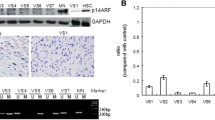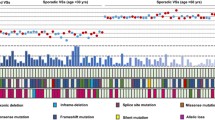Abstract
The events leading to Schwannomas development are still largely unknown. Some studies have demonstrated that merlin acts as a tumor suppressor by blocking Ras-mediated signaling. In this study, we analyze the clinical and biological behaviors of seven randomly selected sporadic vestibular Schwannomas removed from the patients. We find that merlin was commonly lost in these Schwannomas, due to loss of merlin expression or phosphorylation status of merlin expression. Heightened CDKs/cyclins signal transduction concomitant with loss of p27 was well correlated with loss of functional merlin in Schwannomas. More, we show that phosphorylated merlin Schwannomas exhibited increased Ras/Rac/PAK signal transduction. That was in agreement with the severe clinical behaviors, i.e., phosphorylation status of merlin increased tumor size in sporadic vestibular Schwannomas. These results led us to suggest that phosphorylated merlin, a kind of type of mutation merlin, is involved in tumorigenesis of sporadic vestibular Schwannomas.



Similar content being viewed by others
References
Gutmann DH, Aylsworth A, Carey JC et al (1997) The diagnostic evaluation and multidisciplinary management of neurofibromatosis 1 and neurofibromatosis 2. JAMA 278:51–57. doi:10.1001/jama.278.1.51
Antinheimo J, Sankila R, Carpen O et al (2000) Population-based analysis of sporadic and NF2-associated meningiomas and schwannomas. Neurology 54:71–76
Zwarthoff EC (1996) Neurofibromatosis and associated tumor suppressor genes. Pathol Res Pract 192:647–657
McClatchey AI, Saotome I, Mercer K et al (1998) Mice heterozygous for a mutation at the Nf2 tumor suppressor locus develop a range of highly metastatic tumors. Genes Dev 12:1121–1133. doi:10.1101/gad.12.8.1121
Giovannini M, Robanus-Maandag E, van der Valk M et al (2000) Conditional biallelic Nf2 mutation in the mouse promotes manifestations of human neurofibromatosis type 2. Genes Dev 14:1617–1630
Murthy A, Gonzalez–Agosti C, Cordero E et al (1998) NHE-RF, a regulatory cofactor for Na+-H+ exchange, is a common interactor for merlin and ERM proteins. J Biol Chem 273:1273–1276. doi:10.1074/jbc.273.3.1273
Sainio M, Zhao F, Heiska L et al (1997) Neurofibromatosis 2 tumor suppressor protein colocalizes with ezrin and CD44 and associates with actin-containing cytoskeleton. J Cell Sci 110:2249–2260
Hitotsumatsu T, Iwaki T, Kitamoto T et al (1997) Expression of neurofibromatosis 2 protein in human brain tumors: an immunohistochemical study. Acta Neuropathol 93:225–232. doi:10.1007/s004010050608
Huynh DP, Mautner V, Baser ME et al (1997) Immunohistochemical detection of schwannomin and neurofibromin in vestibular Schwannomas, ependymomas and meningiomas. J Neuropathol Exp Neurol 56:382–390. doi:10.1097/00005072-199704000-00007
Stemmer-Rachamimov AO, Gonzalez-Agosti C, Xu L et al (1997) Expression of NF2-encoded merlin and related ERM family proteins in the human central nervous system. J Neuropathol Exp Neurol 56:735–742. doi:10.1097/00005072-199705000-00004
Lutchman M, Rouleau GA (1995) The neurofibromatosis type 2 gene product, schwannomin, suppresses growth of NIH 3T3 cells. Cancer Res 55:2270–2274
Tikoo A, Varga M, Ramesh V et al (1994) An anti-Ras function of neurofibromatosis type 2 gene product (NF2/Merlin). J Biol Chem 269:23387–23390
Morrison H, Sherman LS, Legg J et al (2001) The NF2 tumor suppressor gene product, merlin, mediates contact inhibition of growth through interactions with CD44. Genes Dev 15:968–980. doi:10.1101/gad.189601
Schulze KM, Hanemann CO, Muller HW, Hanenberg H (2002) Transduction of wild-type merlin into human Schwannoma cells decreases Schwannoma cell growth and induces apoptosis. Hum Mol Genet 11:69–76. doi:10.1093/hmg/11.1.69
Sherman L, Xu HM, Geist RT et al (1997) Interdomain binding mediates tumor growth suppression by the NF2 gene product. Oncogene 15:2505–2509. doi:10.1038/sj.onc.1201418
Elledge SJ, Winston J, Harper JW (1996) A question of balance: the role of cyclin-kinase inhibitors in development and tumorigenesis. Trends Cell Biol 6:388–392. doi:10.1016/0962-8924(96)10030-1
Hannon GJ, Beach D (1994) p15INK4B is a potential effector of TGF-b-induced cell cycle arrest. Nature 371:257–261. doi:10.1038/371257a0
Harper JW, Adami GR, Wei N et al (1993) The p21 Cdk-interacting protein Cip1 is a potent inhibitor of G1 cyclindependent kinases. Cell 75:805–816. doi:10.1016/0092-8674(93)90499-G
Reynisdóttir I, Polyak K, Iavarone A, Massague J (1995) Kip/Cip and Ink4 Cdk inhibitors cooperate to induce cell cycle arrest in response to TGF-b. Genes Dev 9:1831–1845. doi:10.1101/gad.9.15.1831
Tang JJ, Shen C, Lu YJ (2006) Requirement for pre-existing of p21 to prevent doxorubicin-induced apoptosis through inhibition of caspase-3 activation. Mol Cell Biochem 291:139–144. doi:10.1007/s11010-006-9206-7
Lu YJ, Tatsuka M, Takebe H, Yagi T (2000) Involvement of cyclin-dependent kinases in doxorubicin-induced apoptosis in human tumor cells. Mol Carcinog 29:1–7 doi: 10.1002/1098-2744(200009)29:1<l::AID-MC1>3.0.CO;2-A
Lu YJ, Yamagishi N, Yagi T, Takebe H (1998) Mutated p21WAF1/CIP1/SDI1 lacking CDK-inhibitory activity fails to prevent apoptosis in human colorectal carcinoma cells. Oncogene 16:705–712. doi:10.1038/sj.onc.1201585
Morrison H, Sperka T, Manent J et al (2007) Merlin/neurofibromatosis type 2 suppresses growth by inhibiting the activation of Ras and Rac. Cancer Res 67:520–527. doi:10.1158/0008-5472.CAN-06-1608
Okada T, Lopez-Lago M, Giancotti FG (2005) Merlin/NF-2 mediates contact inhibition of growth by suppressing recruitment of Rac to the plasma membrane. J Cell Biol 171:361–371. doi:10.1083/jcb.200503165
Lu YJ, Yamagishi N, Miyakoshi J et al (1996) Sites and types of UV-induced mutations leading to inactivation of the growth-arresting activity in p21 (waf1)(sdi1/cip1/waf1) cDNA. Carcinogenesis 17:2343–2345. doi:10.1093/carcin/17.11.2343
Xiao GH, Gallagher R, Shetler J et al (2005) The NF2 tumor suppressor gene product, merlin, inhibits cell proliferation and cell cycle progression by repressing cyclin D1 expression. Mol Cell Biol 25:2384–2394. doi:10.1128/MCB.25.6.2384-2394.2005
Jin H, Sperka Y, Herrlich P, Morrison H (2006) Tumorigenic transformation by CPI-17 through inhibition of a merlin phosphatase. Nature 442:576–579. doi:10.1038/nature04856
Kim H, Lim JY, Kim YH et al (2002) Inhibition of Ras-mediated activator protein 1 activity and cell growth by merlin. Mol Cells 14:108–114
Shaw RJ, Paez JG, Curto M et al (2001) The Nf2 tumor suppressor, merlin, functions in Rac-dependent signaling. Dev Cell 1:63–72. doi:10.1016/S1534-5807(01)00009-0
Xiao GH, Beeser A, Chernoff J, Testa JR (2002) p21-activated kinase links Rac/Cdc42 signaling to merlin. J Biol Chem 277:883–886. doi:10.1074/jbc.C100553200
Chadee DN, Xu DZ, Hung G et al (2006) Mixed-lineage kinase 3 regulates B-Raf through maintenance of the B-Raf/Raf-1 complex and inhibition by the NF2 tumor suppressor protein. Proc Natl Acad Sci USA 103:4463–4468. doi:10.1073/pnas.0510651103
Rong LR, Tang XL, Gutmann DH, Ye K (2004) Neurofibromatosis 2 (NF2) tumor suppressor merlin inhibits phosphatidylinositol 3-kinase through binding to PIKE. Proc Natl Acad Sci USA 101:18200–18205. doi:10.1073/pnas.0405971102
Acknowledgments
This work was supported by the Natural Science Foundation of China (30672293).
Author information
Authors and Affiliations
Corresponding author
Additional information
Zhaoyan Wang and Yanjun Lu have contributed equally to this work.
Rights and permissions
About this article
Cite this article
Wang, Z., Lu, Y., Tang, J. et al. The phosphorylation status of merlin in sporadic vestibular Schwannomas. Mol Cell Biochem 324, 201–206 (2009). https://doi.org/10.1007/s11010-008-0014-0
Received:
Accepted:
Published:
Issue Date:
DOI: https://doi.org/10.1007/s11010-008-0014-0




